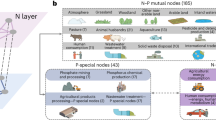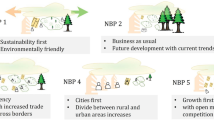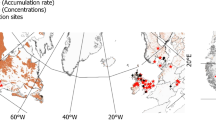Abstract
The resilience of the phosphorus (P) cycling network is critical to ecosystem functioning and human activities. Although P cycling pathways have been previously mapped, a knowledge gap remains in evaluating the P network’s ability to withstand shocks or disturbances. Applying principles of mass balance and ecological network analysis, we examine the network resilience of P cycling in China from 1600 to 2012. The results show that changes in network resilience have shifted from being driven by natural P flows for food production to being driven by industrial P flows for chemical fertilizer production. Urbanization has intensified the one-way journey of P, further deteriorating network resilience. Over 2000–2012, the network resilience of P cycling has decreased by 11% owing to dietary changes towards more animal-based foods. A trade-off between network resilience improvement and increasing food trade is also observed. These findings can support policy decisions for enhanced P cycling network resilience in China.
This is a preview of subscription content, access via your institution
Access options
Access Nature and 54 other Nature Portfolio journals
Get Nature+, our best-value online-access subscription
$29.99 / 30 days
cancel any time
Subscribe to this journal
Receive 12 digital issues and online access to articles
$119.00 per year
only $9.92 per issue
Buy this article
- Purchase on Springer Link
- Instant access to full article PDF
Prices may be subject to local taxes which are calculated during checkout





Similar content being viewed by others
Data availability
Calculations to generate 149-node P flow networks used data from Liu et al.12. All data used in this study are available from the corresponding authors upon reasonable request. Source data are provided with this paper.
Code availability
All computer codes generated in MATLAB 2019a and R version 3.6.1 for this study are available from the corresponding authors upon reasonable request.
References
Cordell, D., Drangert, J.-O. & White, S. The story of phosphorus: global food security and food for thought. Glob. Environ. Change 19, 292–305 (2009).
Elser, J. & Bennett, E. Phosphorus cycle: a broken biogeochemical cycle. Nature 478, 29–31 (2011).
Scholz, R. W. & Wellmer, F.-W. Although there is no physical short-term scarcity of phosphorus, its resource efficiency should be improved. J. Ind. Ecol. 23, 313–318 (2019).
Ulanowicz, R. E. The dual nature of ecosystem dynamics. Ecol. Model. 220, 1886–1892 (2009).
Carpenter, S. R. & Bennett, E. M. Reconsideration of the planetary boundary for phosphorus. Environ. Res. Lett. 6, 014009 (2011).
Steffen, W. et al. Planetary boundaries: guiding human development on a changing planet. Science 347, 1259855 (2015).
Chen, M. & Graedel, T. A half-century of global phosphorus flows, stocks, production, consumption, recycling, and environmental impacts. Glob. Environ. Change 36, 139–152 (2016).
Chowdhury, R. B., Moore, G. A., Weatherley, A. J. & Arora, M. A review of recent substance flow analyses of phosphorus to identify priority management areas at different geographical scales. Resour. Conserv. Recycl. 83, 213–228 (2014).
Reinhard, C. T. et al. Evolution of the global phosphorus cycle. Nature 541, 386–389 (2017).
Yuan, Z. et al. Human perturbation of the global phosphorus cycle: changes and consequences. Environ. Sci. Technol. 52, 2438–2450 (2018).
Smil, V. Phosphorus in the environment: natural flows and human interferences. Annu. Rev. Energy Env. 25, 53–88 (2000).
Liu, X. et al. Intensification of phosphorus cycling in China since the 1600s. Proc. Natl Acad. Sci. USA 113, 2609–2614 (2016).
MacDonald, G. K. et al. Guiding phosphorus stewardship for multiple ecosystem services. Ecosyst. Health Sustain. 2, e01251 (2016).
Sattari, S. Z., van Ittersum, M. K., Giller, K. E., Zhang, F. & Bouwman, A. F. Key role of China and its agriculture in global sustainable phosphorus management. Environ. Res. Lett. 9, 054003 (2014).
Chen, M., Sun, F., Xia, X. & Chen, J. The phosphorus flow in China: a revisit from the perspective of production. Glob. Environ. Res. 19, 19–25 (2015).
Cui, S. et al. Changing urban phosphorus metabolism: evidence from Longyan City, China. Sci. Total Environ. 536, 924–932 (2015).
Li, G.-L., Bai, X., Yu, S., Zhang, H. & Zhu, Y.-G. Urban phosphorus metabolism through food consumption: the case of China. J. Ind. Ecol. 16, 588–599 (2012).
Li, S., Yuan, Z., Bi, J. & Wu, H. Anthropogenic phosphorus flow analysis of Hefei City, China. Sci. Total Environ. 408, 5715–5722 (2010).
Ma, L. et al. Nitrogen and phosphorus use efficiencies and losses in the food chain in China at regional scales in 1980 and 2005. Sci. Total Environ. 434, 51–61 (2012).
Qiao, M., Zheng, Y.-M. & Zhu, Y.-G. Material flow analysis of phosphorus through food consumption in two megacities in northern China. Chemosphere 84, 773–778 (2011).
Yuan, Z., Liu, X., Wu, H., Zhang, L. & Bi, J. Anthropogenic phosphorus flow analysis of Lujiang County, Anhui Province, Central China. Ecol. Model. 222, 1534–1543 (2011).
Yuan, Z., Sun, L., Bi, J., Wu, H. & Zhang, L. Phosphorus flow analysis of the socioeconomic ecosystem of Shucheng County, China. Ecol. Appl. 21, 2822–2832 (2011).
Bi, J., Chen, Q., Zhang, L. & Yuan, Z. Quantifying phosphorus flow pathways through socioeconomic systems at the county level in China. J. Ind. Ecol. 17, 452–460 (2013).
Jiang, S. & Yuan, Z. Phosphorus flow patterns in the Chaohu watershed from 1978 to 2012. Environ. Sci. Technol. 49, 13973–13982 (2015).
Yuan, Z., Shi, J., Wu, H., Zhang, L. & Bi, J. Understanding the anthropogenic phosphorus pathway with substance flow analysis at the city level. J. Environ. Manag. 92, 2021–2028 (2011).
Bai, Z. et al. Changes in phosphorus use and losses in the food chain of China during 1950–2010 and forecasts for 2030. Nutr. Cycl. Agroecosyst. 104, 361–372 (2016).
Li, G. et al. Identifying potential strategies in the key sectors of China’s food chain to implement sustainable phosphorus management: a review. Nutr. Cycl. Agroecosyst. 104, 341–359 (2016).
Ma, D., Hu, S., Chen, D. & Li, Y. Substance flow analysis as a tool for the elucidation of anthropogenic phosphorus metabolism in China. J. Clean. Prod. 29–30, 188–198 (2012).
Ma, D., Hu, S., Chen, D. & Li, Y. The temporal evolution of anthropogenic phosphorus consumption in China and its environmental implications. J. Ind. Ecol. 17, 566–577 (2013).
Wang, F. et al. The phosphorus footprint of China’s food chain: implications for food security, natural resource management, and environmental quality. J. Environ. Qual. 40, 1081–1089 (2011).
Ma, L. et al. Modeling nutrient flows in the food chain of China. J. Environ. Qual. 39, 1279 (2010).
Ulanowicz, R. E. Growth and Development: Ecosystems Phenomenology (Springer, 1986).
Kharrazi, A., Rovenskaya, E. & Fath, B. D. Network structure impacts global commodity trade growth and resilience. PLoS ONE 12, e0171184 (2017).
Goerner, S. J., Lietaer, B. & Ulanowicz, R. E. Quantifying economic sustainability: implications for free-enterprise theory, policy and practice. Ecol. Econ. 69, 76–81 (2009).
Helin, J. & Weikard, H.-P. A model for estimating phosphorus requirements of world food production. Agric. Syst. 176, 102666 (2019).
World Urbanization Prospects: The 2018 Revision; https://population.un.org/wup/country-profiles/ (United Nations, 2018).
Global Food Losses and Food Waste – Extent, Causes and Prevention (FAO, 2011).
Zhang, W. et al. Efficiency, economics, and environmental implications of phosphorus resource use and the fertilizer industry in China. Nutr. Cycl. Agroecosyst. 80, 131–144 (2008).
Liu, G. Food Losses and Food Waste in China: A First Estimate OECD Food, Agriculture and Fisheries Papers No. 66 (OECD, 2014).
Roy, R. N., Finck, A., Blair, G. J. & Tandon, H. L. S. Plant Nutrition for Food Security. A Guide for Integrated Nutrient Management (FAO, 2006).
Cieślik, B. & Konieczka, P. A review of phosphorus recovery methods at various steps of wastewater treatment and sewage sludge management. The concept of “no solid waste generation” and analytical methods. J. Clean. Prod. 142, 1728–1740 (2017).
Yokoyama, K. et al. Separation and recovery of phosphorus from steelmaking slags with the aid of a strong magnetic field. ISIJ Int. 47, 1541–1548 (2007).
Action Plan for Zero Increase in Fertilizer Use by 2020 (Ministry of Agriculture, 2015); http://jiuban.moa.gov.cn/zwllm/tzgg/tz/201503/t20150318_4444765.htm
UN Environment Programme, International Resource Panel (2018); http://www.resourcepanel.org
Chen, S. & Chen, B. Urban energy–water nexus: a network perspective. Appl. Energy 184, 905–914 (2016).
Fath, B. D. Quantifying economic and ecological sustainability. Ocean Coast. Manag. 108, 13–19 (2015).
Panyam, V., Huang, H., Davis, K. & Layton, A. Bio-inspired design for robust power grid networks. Appl. Energy 251, 113349 (2019).
Kharrazi, A. & Fath, B. D. Measuring global oil trade dependencies: an application of the point-wise mutual information method. Energy Policy 88, 271–277 (2016).
Ang, B. W. & Zhang, F. Q. A survey of index decomposition analysis in energy and environmental studies. Energy 25, 1149–1176 (2000).
Weik, M. H. in Computer Science and Communications Dictionary (ed. Weik, M. H.) 1074–1074 (Springer, 2001).
Acknowledgements
This work was supported by the National Natural Science Foundation of China (71874014, 51721093, 71704055, 71704015 and 41661144023), the European Union’s Horizon 2020 research and innovation programme under the Marie Skłodowska-Curie grant agreement CIFTRESS no. 840205, Natural Science Funds for Distinguished Young Scholar of Guangdong Province, China (2018B030306032) and the Fundamental Research Funds for the Central Universities.
Author information
Authors and Affiliations
Contributions
S.L., Y.Y., A.K. and Z.M. designed the study. S.L. and Y.Y. collected data and conducted calculations. S.L., Y.Y., A.K., B.D.F., G.T.D. and S.C. led the analysis. S.L., Y.Y., A.K., B.D.F., C.F., G.T.D., S.C., T.M., B.Z., Z.M. and Z.Y. contributed to the writing.
Corresponding authors
Ethics declarations
Competing interests
The authors declare no competing interests.
Additional information
Publisher’s note Springer Nature remains neutral with regard to jurisdictional claims in published maps and institutional affiliations.
Extended data
Extended Data Fig. 1 Distribution of values for the resilience of the P cycling network in China during 1600–2012.
The resilience values of the P cycling network during 1600–2012 are distributed in the curve of the theoretical relationship between resilience and α.
Extended Data Fig. 2 Changes of human P demand in China during 1950–2012.
The contribution of each category of P demand to the total P demand is shown in a different colour.
Extended Data Fig. 3 Changes of food structure in China during 1950–2012.
Food structure is calculated as the sum of P content in all foods except for grain divided by P content in grain.
Extended Data Fig. 4 Uncertainties in the efficiency, redundancy, α, and resilience of the P cycling network in China during 1600–2012.
Uncertainties are calculated by Monte Carlo simulation sampling 10,000 times. The upper boundary of the range indicates maximum values; the lower boundary of the range represents minimum values; and the solid line stands for average values.
Extended Data Fig. 5 Comparisons of α values between the 149-node and 16-node networks.
The overly efficient area is separated from the overly redundant area by the line where α = 0.3679 in the figure.
Extended Data Fig. 6 Comparisons of network resilience between the 149-node and 16-node networks.
The maximum value of resilience is 0.3679 in the figure.
Supplementary information
Supplementary Information
Supplementary Table 1 title and caption, Tables 2–11, notes, methods, discussion and references.
Supplementary Table 1
The list of nodes in the Chinese P cycling network.
Source data
Source Data Fig. 1
Resilience, α, and efficiency and redundancy of the P cycling network in China during 1600–2012.
Source Data Fig. 2
Relative contributions of changes in efficiency and redundancy to changes in the resilience of the P cycling network in China during 1600–2012.
Source Data Fig. 3
Relative contributions of changes in concentration degree of P flows, node inter-dependency and node inter-independency to changes in efficiency, redundancy, and resilience of the P cycling network in China during 1600–2012.
Source Data Fig. 4
Contributions of changes in links and nodes to changes in the resilience of the P cycling network in China during 2000–2012.
Source Data Fig. 5
The P flow network of China in 2012.
Source Data Extended Data Fig. 1
α and resilience of the P cycling network in China during 1600–2012.
Source Data Extended Data Fig. 2
Human P demand in China during 1950–2012.
Source Data Extended Data Fig. 3
Food structure in China during 1950–2012.
Source Data Extended Data Fig. 4
Uncertainties in the efficiency, redundancy, α, and resilience of the P cycling network in China during 1600–2012.
Source Data Extended Data Fig. 5
α values for the 149-node and 16-node P cycling networks in China during 1600–2012.
Source Data Extended Data Fig. 6
Network resilience for the 149-node and 16-node P cycling networks in China during 1600–2012.
Rights and permissions
About this article
Cite this article
Liang, S., Yu, Y., Kharrazi, A. et al. Network resilience of phosphorus cycling in China has shifted by natural flows, fertilizer use and dietary transitions between 1600 and 2012. Nat Food 1, 365–375 (2020). https://doi.org/10.1038/s43016-020-0098-6
Received:
Accepted:
Published:
Issue Date:
DOI: https://doi.org/10.1038/s43016-020-0098-6
This article is cited by
-
Decreasing resilience of China’s coupled nitrogen–phosphorus cycling network requires urgent action
Nature Food (2024)
-
Assessing urban low-carbon performance from a metabolic perspective
Science China Earth Sciences (2021)
-
Resilience of phosphorus cycling
Nature Food (2020)



